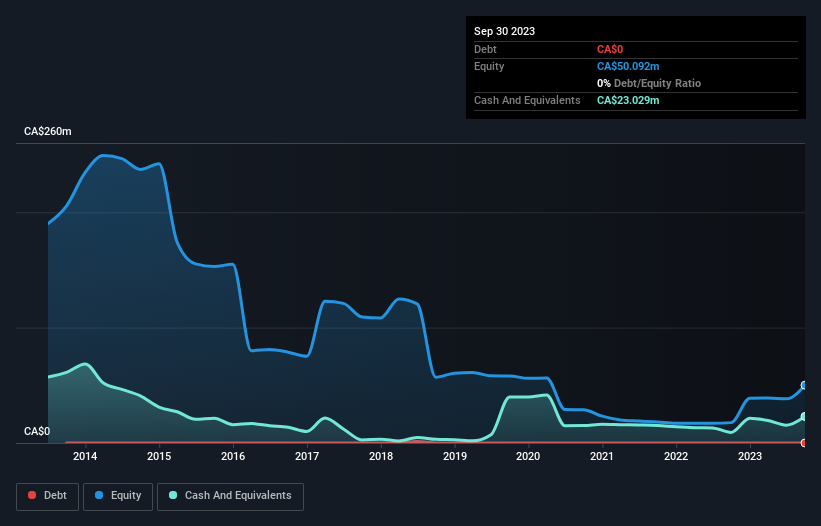Is TAG Oil (CVE:TAO) In A Good Position To Deliver On Growth Plans?
There's no doubt that money can be made by owning shares of unprofitable businesses. For example, although software-as-a-service business Salesforce.com lost money for years while it grew recurring revenue, if you held shares since 2005, you'd have done very well indeed. Nonetheless, only a fool would ignore the risk that a loss making company burns through its cash too quickly.
So, the natural question for TAG Oil (CVE:TAO) shareholders is whether they should be concerned by its rate of cash burn. For the purpose of this article, we'll define cash burn as the amount of cash the company is spending each year to fund its growth (also called its negative free cash flow). First, we'll determine its cash runway by comparing its cash burn with its cash reserves.
Check out our latest analysis for TAG Oil
How Long Is TAG Oil's Cash Runway?
A company's cash runway is calculated by dividing its cash hoard by its cash burn. As at September 2023, TAG Oil had cash of CA$23m and no debt. Importantly, its cash burn was CA$21m over the trailing twelve months. Therefore, from September 2023 it had roughly 13 months of cash runway. Notably, one analyst forecasts that TAG Oil will break even (at a free cash flow level) in about 19 months. That means it doesn't have a great deal of breathing room, but it shouldn't really need more cash, considering that cash burn should be continually reducing. The image below shows how its cash balance has been changing over the last few years.
How Is TAG Oil's Cash Burn Changing Over Time?
In our view, TAG Oil doesn't yet produce significant amounts of operating revenue, since it reported just CA$569k in the last twelve months. Therefore, for the purposes of this analysis we'll focus on how the cash burn is tracking. Remarkably, it actually increased its cash burn by 429% in the last year. With that kind of spending growth its cash runway will shorten quickly, as it simultaneously uses its cash while increasing the burn rate. Clearly, however, the crucial factor is whether the company will grow its business going forward. So you might want to take a peek at how much the company is expected to grow in the next few years.
How Hard Would It Be For TAG Oil To Raise More Cash For Growth?
Given its cash burn trajectory, TAG Oil shareholders may wish to consider how easily it could raise more cash, despite its solid cash runway. Generally speaking, a listed business can raise new cash through issuing shares or taking on debt. Many companies end up issuing new shares to fund future growth. By comparing a company's annual cash burn to its total market capitalisation, we can estimate roughly how many shares it would have to issue in order to run the company for another year (at the same burn rate).
TAG Oil has a market capitalisation of CA$111m and burnt through CA$21m last year, which is 19% of the company's market value. Given that situation, it's fair to say the company wouldn't have much trouble raising more cash for growth, but shareholders would be somewhat diluted.
So, Should We Worry About TAG Oil's Cash Burn?
On this analysis of TAG Oil's cash burn, we think its cash burn relative to its market cap was reassuring, while its increasing cash burn has us a bit worried. There's no doubt that shareholders can take a lot of heart from the fact that at least one analyst is forecasting it will reach breakeven before too long. While we're the kind of investors who are always a bit concerned about the risks involved with cash burning companies, the metrics we have discussed in this article leave us relatively comfortable about TAG Oil's situation. Separately, we looked at different risks affecting the company and spotted 3 warning signs for TAG Oil (of which 1 is concerning!) you should know about.
If you would prefer to check out another company with better fundamentals, then do not miss this free list of interesting companies, that have HIGH return on equity and low debt or this list of stocks which are all forecast to grow.
Have feedback on this article? Concerned about the content? Get in touch with us directly. Alternatively, email editorial-team (at) simplywallst.com.
This article by Simply Wall St is general in nature. We provide commentary based on historical data and analyst forecasts only using an unbiased methodology and our articles are not intended to be financial advice. It does not constitute a recommendation to buy or sell any stock, and does not take account of your objectives, or your financial situation. We aim to bring you long-term focused analysis driven by fundamental data. Note that our analysis may not factor in the latest price-sensitive company announcements or qualitative material. Simply Wall St has no position in any stocks mentioned.

 Yahoo Finance
Yahoo Finance 
